|

Knowing that this man is an icon of horsemanship and show jumping, I reluctantly
emailed the contact person to see if there were still openings. The answer was yes. The next thing I knew we were going to
Morven Park to train with George Morris. Having heard all “the stories” about George, our tack was immaculate,
our horse well turned out, our clothing classic and simple, and certainly no ‘bling.’
We watched videos of George teaching on YouTube to get prepared and took
our last lesson prior to the clinic. The trainer has been to George’s teacher’s training so she came ready to
prep us. Jumping was a no brainer, but when she told us we had to canter ten meter circles around one jump going first left
then right after each jump, and then sit at the canter for equitation, we knew it would be a challenging week. We thought
we were ready because our tack was clean and the horse well groomed, little did we know what lay ahead.
Overall, this clinic was fascinating, and for three days George Morris gave
over six hours of instruction. I never got bored. George has such a command of his sport, that his seriousness is not to be
taken lightly. All riders going in knew this and few, if any, balked at anything George said. I watched in amazement and listened
intently to the simplicity of his words, not always kind, and the effectiveness of his teaching. My horse, Mister Matthew
( Matty) and rider ( Adriana) had one major goal, other than to learn everything they could, but to hear one compliment from
George. And, we got it: “nice horse, good jumper!” The rider, on the other hand, was “pretty, but ineffective.
Pretty is as pretty does....,” stated George.

As a trainer for basic dressage for about 30 years, I always told my students
that a jump is a canter stride over a fence, and one could ride walk, trot and canter in jumping position, or two point, with
no hands, then one is ready to jump -- little did I know all the details involved. I also told my students that the first
half of George Morris’s book, Hunter Seat Equitation was about flat work or dressage and to read it. As George
is quoted, “you make a rider on the flat and a jumper on the flat.” When I returned from the clinic, I asked one
of my students who rode hunt seat for about ten years if she ever did shoulder-in or haunches-in in any of her lessons, and
she said “no.” Wow, I thought, this is what half of George’s lessons were about: “schooling the horse
on the flat, which is dressage, and this is neglected." "What you do over a fence, you fix on the flat,” stated George.
| Adriana riding in background, and Olympian |
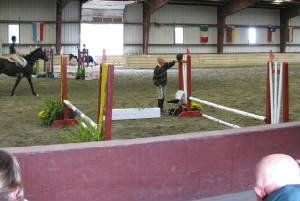
|
| Leslie Law's head to the lower right. |
Each session began with “schooling movements,” or flat work.
During this time riders learned how to use their aids effectively to train the horse on the flat. “A properly ridden
horse is round,” according to George, and “horses that are muscled correctly will not need the vet.” The
advance class did shoulder-in, haunches-in and lots of changes of leads. I figured out from the first two hour advance lesson,
that my horses at home were definitely “lady trained,” as George so blatantly pointed out about one of the horses
he rode and when he dismounted. He talked about getting the horses “on the aids” as opposed to “on
the bit,” and that a rider needs to bend the horse at the rib cage with the leg and not the neck with the rein. He wanted
his horses straight in the neck and not bent. Although, he did do a lot of counter bending to keep a canter lead and/or for
lead changes. He spoke a lot and demonstrated how a rider needs to turn the horse’s shoulders with the outside rein
but, he did not hesitate to use an opening rein when needed. He rode a horse when needed, and praised the concept of demonstration
but mainly used an assistant named Kali ( working student of Beezy Maddens) to ride most horses that were being difficult
or assist riders who did not compliment the horse.
At one point George beckoned to ride “the brown horse.” Ha,
that was us, even though my horse is bay. My rider ignored him hoping he was seeking another mount. But, no, George wanted
my alpha thoroughbred! I did not know what to do -- of course, I am on the side lines muted. The last man to mount Matty
was spun into a rearing whirlwind after mounting. And, I knew if Matty pulled his stuff with George, George was not going
to back down. I prayed. George got a leg up and Mister Matthew was an angel. Thank God, because George, for as good as he
is, is an aged gent. Nevertheless, George Morris even jumped my horse! Now, that is almost better than the compliment, “nice
horse, good jumper.” When Adriana got back up, she thought twice about removing the hand print George left behind on
Matty’s loins. She was nervous thinking George might comment on the dust in Matty’s coat.
At this clinic the auditors were treated to observe a Gold Medalist
riding in the advanced section. His name is Leslie Law and he is an event rider. George constantly reminded the auditors and
riders to mimic Leslie’s soft and effective riding. His horses were relaxed, rhythmic, round, light, forward without
rushing and, well, to me they looked very “dressagey.”
| Warming Matty up. George likes a higher poll |
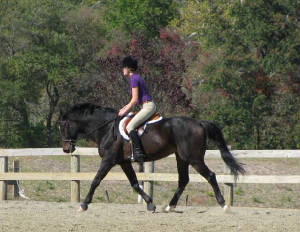
|
| than this, but still soft in the jaw. |
George talked constantly about classical riding: “basics don’t
change, mechanics of jumping don’t change, and fundamentals of style don’t change.” And, more then once,
on all three days, he mentioned that riders have become seat or “buttock” riders, or “butt grabbers.”
George is all about the forward seat, or “crotch” riding. A rider needs to be out of the saddle over a fence so
the horse can arc its back. He said he does not like to use the word sit on the horse, he says to “sink on the horse.”
He said riders have become seat obsessed and that we need to ride the horse with our legs and hands. The legs produce impulsion
and the hands guide, and that the seat will take care of itself. He was adamant that riders forget about the seat, and he
said he disagreed with all that talk in the magazines about seat, seat, seat. “I don’t talk about the seat much.
Use of the seat just happens naturally; it is our enforcer” stated George. If a rider is to use the seat, when
needed, it is 20 percent of the time when jumping,not all the time. Or, in other words, there are three ways to ride a horse,
"with a horse", "behind a horse", and "ahead of the horse or motion". According to George, riding ahead of the motion will
never be right.
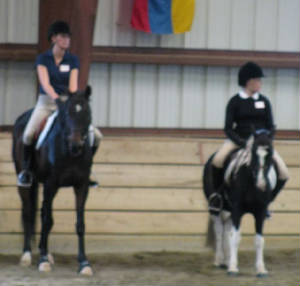
Waiting and watching on the sidelines. Always alert
and attentive, lest George turn around and see you
slouching! “Next,” he would yell, and you better be
ready to jump. “Lets not waste time people,” George
would say. George’s comment about the pony, “this
pony is an incredible jumper, but the rider needs a
bigger mount.” If you ride with George Morris you
are going to hear the truth!
George wants riders to "become leg obsessed, but that does not mean kicking".
If you kicked your horse, he reprimanded you. However, all riders wore spurs and carried a stick. “We teach the horse
with artificial aids to get the horse to respond better to the natural aids,” stated George. He said it is not so much
the strength of the stick, but the noise. Riders had to learn when to use the stick right at the base of the jump, if they
thought the horse might hesitate. ”He who hesitates is lost,” says George. To use the stick a rider had to take
the hand off the rein and use the stick behind the leg. It was amazing how good a rider got at this when needed. But, once
you got good at it, George would then yell, “do not get stick happy.” Riders were expected to be able to use the
stick with both hands and also be able to hold the stick in the right hand, but be able to cross it over the withers to the
left and use it on the other side. There was also a threatening position of the stick when it was held up right toward the
horse’s head, and there was “resting the stick,” or letting it just lie on the horse’s side, as if
so say, “I am here...you better stay forward.” There is no doubt George expected athletes not only of the horses
but of the riders as well.
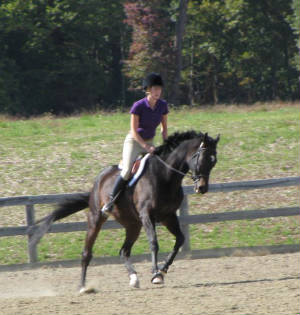
Warming up Matty prior to George’s lesson.
His poll is high, where George likes it, he is
straight from the withers forward and bending
in his body from the rider’s leg. The rider’s hands
are too low
for George, she needs to bring them
up so they are above the withers. “Bearing down
with a rein, is a kiss of death,“says George.
If you were too big for your horse, or bulging in your britches, George
let you know. To be a rider you need to be fit and riding a horse that is suited to you ! He said riding is not a cute sport,
like all the magazines portray today, but a serious sport. On the other hand, however, George reiterated that “People,
this sport is not complicated. You cannot reinvent the wheel. Always strive to make the basics better.”
George reprimanded riders if they got rough with a horse. He especially
disdained rough hands and heavy seats. “You do not muscle and force a horse,” he cautioned,“ or, "get a
quick temper with your horse. Quick is almost always rough, wait for a horse.” An “educated rider” has a
correct position and your “position or form gives you correct function on the horse.” First a rider has to learn
a correct position, then the function of the position, such as being an effective rider. As George says “what gets function
is from correct form.” He divided the riding position into the legs from the knee down, the seat which is the base,
or thigh and seat, then the arms and hands, which should be elastic at all times, and then the upper body. He also emphasized
that the most important aid for the rider is the brain! “Think people, think...” he said way too many times.
Throughout the three days, George systematically taught exercises to
teach riders pace, straight lines, and distance over fences. He especially taught when to sit on the horse prior to a jump,
(which is hardly often) but, it was okay for a more difficult jump such as a water jump. He also covered automatic releases
for the advance riders and said ”a rider will get extra points in the Medal McClay if they do an automatic release.”
He covered course analysis, short releases, the importance of elbows following, heels being down, stirrups on the balls of
the feet; “if your foot is not correctly placed in the stirrup, nothing above it will be in balance or in correct position,”
he hammered. He also taught riding straight lines through gymnastics and using an effective opening rein, to not ducking onto
a horse over a jump, to jumping ahead of the horse or behind the horse.... His exercises and commentary were endless. His
words of wisdom were verbalized with intent, we were there to learn and George made sure of it.
I learned words such as “hooking,” a British term that describes when a rider grabs,
or hooks the horse in the mouth, to “rapping,” which, according to George, “educated rapping,” when
a horse on its own accord, knocks a railing, “can teach the horse to jump better.” We learned that the
French school invented the rein aids, and, by golly if you were riding with George you had better know what they were, and
that an Italian named Captain Federico Caprilli invented the forward seat and then each country adapted his concept of the
forward seat to their breed of horses. The Germans rode more with the seat because their horses were heavier and the French
used less seat because their horses were lighter. He talked about books to read, like Capt. Vladimir S. Littauer’s book,
Common Sense Horsemanship, Gordon Wright, to Bert de Nemethy and on and on. He was not name dropping, these were his
friends and colleagues. George was obviously well versed on horses, riding, training, and the history of the classical school
and he wanted us all to be part of this tradition. “Riding is not just jumping,” according to George “it
is schooling your horse on the flat, horsemanship, and education.”
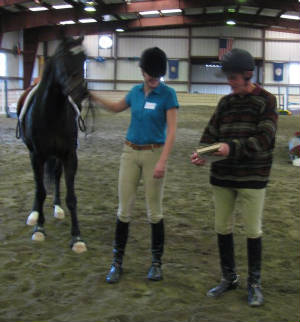
At the end of the clinic, we got the nerve to ask George Morris to autograph
his book. I happened to have a first edition of the book with the original cover of him jumping a beautiful grey horse called
Flying Along. He was gracious and took the pen and asked for our names. Leslie Law came up, as he was going to escort George
home. It must of been a while since George saw a copy of his book with the original cover as he showed it to Leslie and said,
“Look at how handsome I used to be. Let me tell you, I got in a lot of trouble back then.” Adriana and I waited
in awe -- not only did we experience three days of incredible classic instruction with the master horseman, rider and
icon of hunt seat riding, but we experienced the innocent joy of him expressing his youth, his day, his forever life.
Calling all riders! Go and experience George Morris -- you will be glad
you did!
|



